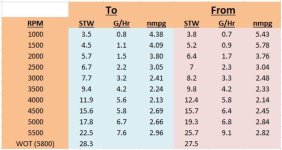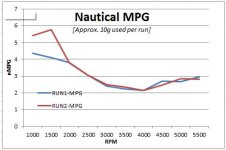Nwheeler
New member
- Joined
- Jul 29, 2021
- Messages
- 10
- Reaction score
- 0
- C Dory Year
- 2006
- C Dory Model
- 25 Cruiser
- Hull Identification Number
- CD025167L506
- Vessel Name
- Sea Sharp
I’msure this is recorded somewhere on the site, but…..
….Coming from 45 years of sailing, fuel was never a big issue. Then we switched to a 34’ slow trawler and ran the ICW……and I paid more attention. But being a heavy displacement boat,the variables were limited to “go slow and save, go faster (plow more) and watch the inevitable curve to the bottom of the tank. But our new boat, a 2007 CD25 brings in the added option of planing. We just repowered from our old Suzuki 150 to a new 200 and I am now on a quest to get some additional data points - or, as Johnny 5 says in Short Circuit; “more input”.
I know that there are a number of ways to gauge fuel usage, but the one I’m trying to nail down is approx MPG. Specifically how it fluctuates up, and then down, and then up again, based on rpm and whether on plane or not. I noticed on the charts from the engine manufacturers, the common knowledge is that the fuel use is best at idle, then decreases up to a point (usually around 2500 rpm), then it increases up until around 3500 (the sweet spot), only to start the draining of the tank in earnest.
So here’s my question: has anyone out there done a real life study on their CD25, using either a 150 or 200hp engine? So far I have found that my boat, at 2200 rpm, runs at a real 3.3 mpg. From the Suzuki charts, I can see that I should actually get better than that by going on plane at 3500.
….Coming from 45 years of sailing, fuel was never a big issue. Then we switched to a 34’ slow trawler and ran the ICW……and I paid more attention. But being a heavy displacement boat,the variables were limited to “go slow and save, go faster (plow more) and watch the inevitable curve to the bottom of the tank. But our new boat, a 2007 CD25 brings in the added option of planing. We just repowered from our old Suzuki 150 to a new 200 and I am now on a quest to get some additional data points - or, as Johnny 5 says in Short Circuit; “more input”.
I know that there are a number of ways to gauge fuel usage, but the one I’m trying to nail down is approx MPG. Specifically how it fluctuates up, and then down, and then up again, based on rpm and whether on plane or not. I noticed on the charts from the engine manufacturers, the common knowledge is that the fuel use is best at idle, then decreases up to a point (usually around 2500 rpm), then it increases up until around 3500 (the sweet spot), only to start the draining of the tank in earnest.
So here’s my question: has anyone out there done a real life study on their CD25, using either a 150 or 200hp engine? So far I have found that my boat, at 2200 rpm, runs at a real 3.3 mpg. From the Suzuki charts, I can see that I should actually get better than that by going on plane at 3500.


